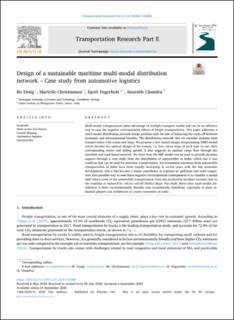| dc.contributor.author | Dong, Bo | |
| dc.contributor.author | Christiansen, Marielle | |
| dc.contributor.author | Fagerholt, Kjetil | |
| dc.contributor.author | Chandra, Saurabh | |
| dc.date.accessioned | 2021-03-12T08:08:07Z | |
| dc.date.available | 2021-03-12T08:08:07Z | |
| dc.date.created | 2020-09-07T14:57:53Z | |
| dc.date.issued | 2020 | |
| dc.identifier.citation | Transportation Research Part E: Logistics and Transportation Review. 2020, 143 . | en_US |
| dc.identifier.issn | 1366-5545 | |
| dc.identifier.uri | https://hdl.handle.net/11250/2733037 | |
| dc.description.abstract | Multi-modal transportation takes advantage of multiple transport modes and can be an effective way to ease the negative environmental effects of freight transportation. This paper addresses a multi-modal distribution network design problem with the aim of balancing the trade-off between economic and environmental benefits. The distribution network that we consider includes both transportation with trucks and ships. We propose a new mixed integer programming (MIP) model which decides the optimal design of the system, i.e. how many ships of each type to use, their corresponding routes and sailing speeds. It also suggests an optimal cargo flow through the maritime and road-based network. We show how the MIP model can be used to provide decision support through a case study from the distribution of automobiles in India, which has a vast coastline that can be used for maritime transportation. Environmental emissions from automobile transportation in India have been rapidly increasing in recent years with the fast economic development, and it has become a major contributor to regional air pollution and road congestion. One possible way to ease these negative environmental consequences is to consider a modal shift where some of the automobile transportation from the production facilities located close to the coastline is replaced by roll-on roll-off (RoRo) ships. Our study shows that multi-modal distribution is both environmentally friendly and economically beneficial, especially if more industrial players can collaborate to create economies of scale. | en_US |
| dc.language.iso | eng | en_US |
| dc.publisher | Elsevier | en_US |
| dc.rights | Navngivelse 4.0 Internasjonal | * |
| dc.rights.uri | http://creativecommons.org/licenses/by/4.0/deed.no | * |
| dc.title | Design of a sustainable maritime multi-modal distribution network – case study from automotive logistics | en_US |
| dc.type | Peer reviewed | en_US |
| dc.type | Journal article | en_US |
| dc.description.version | publishedVersion | en_US |
| dc.source.pagenumber | 15 | en_US |
| dc.source.volume | 143 | en_US |
| dc.source.journal | Transportation Research Part E: Logistics and Transportation Review | en_US |
| dc.identifier.doi | 10.1016/j.tre.2020.102086 | |
| dc.identifier.cristin | 1827860 | |
| cristin.ispublished | true | |
| cristin.fulltext | original | |
| cristin.qualitycode | 1 | |

